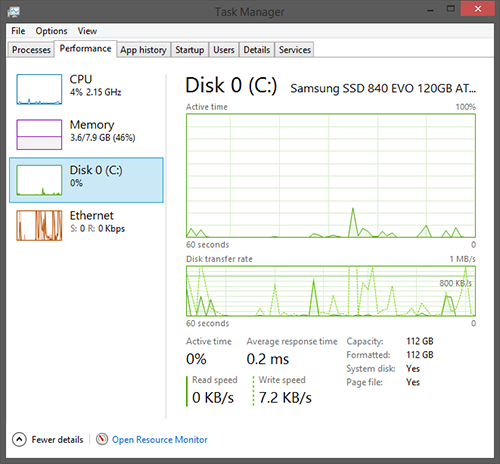Windows (8 & 10) - Using the Windows Task Manager
Note: Your system administrator may have implemented a local policy on your computer to disable Task Manager. In this scenario, you should contact the system administrator or your help desk if you need local process control or the ability to monitor the computer's performance.
- Start task manager
- Start or exit a program
- End a process
- Monitor performance
- Manage startup programs
How to start Task Manager
To start Task Manager, take either of the following actions:
- Press CTRL+ALT+DELETE, and then click Task Manager.

- Right-click an empty area of the taskbar, and then click Task Manager.
If your task manager looks like image below, click More details to expand.
How to start or exit a program
The Processes tab displays the status of the programs that are running on the computer. To exit or start a program, follow these steps:
- Click the Processes tab.
- Do one of the following, as appropriate for the action that you want to perform:
-
Exit a program: To exit a program, click the program that you want to exit, and then click End Task.
Note: When you exit a program in this manner, any unsaved data in that program is lost.
-
Start a program: To start a program, click File > Run new task. In the Create New Task dialog box, click Browse, locate and select the program that you want to start, click Open, and then click OK.
Note: This procedure is very similar to starting a program by using the Run command on the Start menu.
-
How to end a process
The Details tab displays information about the processes that are running on the computer. A process can be an application that you start or subsystems and services that are managed by the operating system. To end a process, follow these steps.
To match a process with a running program, right-click the program name on the Processes tab of Windows Task Manager, and then click Go To Details.
- Click the Details tab.
- Do one of the following, depending on the action that you want to perform:
- If you want to end a single process, click the process that you want to end, and then click End Task.
- If you want to end a process and all processes directly or indirectly related to it, right-click the process that you want to end, and then click End Process Tree.
Note: Proceed with caution when you end a process. If you exit a program in this manner, data that has not been saved will be lost. If you end a system process, a system component may no longer function correctly.
How to monitor your computer's performance
Click the Performance tab to view a dynamic overview of the performance of your computer. Below is an overview of the performance tab.
CPU
|
 |
Memory
|
 |
Disk
|
 |
Connections
|
 |
How to manage your startup programs
To view a list of programs that start when Windows starts, click the Startup tab.
The startup impact column indicates how much each program slows your computer down during startup. To stop a program from launching at startup, select the program that you would like to disable and click Disable.
This document was adapted from the Microsoft Knowledge Base article 323527.




